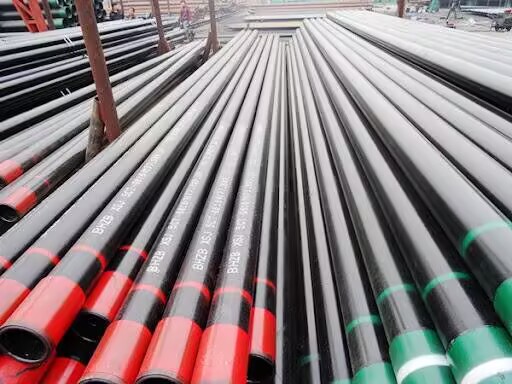API 5CT is a standard technical specification for steel casing and tubing used in oil and gas industry oil Wells, among which API 5CT oil casing is a pipeline for conveying raw materials such as oil and gas Wells, mainly used in the drilling and exploitation process of oil and gas Wells, and plays the role of supporting the well wall, isolating the fluid and transmitting force. In order to meet the performance requirements under different working conditions, API 5CT oil casing is usually through a rigorous production process and heat treatment methods to enhance mechanical properties and durability.

API 5CT Classification of oil casing
Classification by steel grade:
The API standard divides casing steel grades into several grades, namely H-40, J-55, N-80, L-80, C-90, T-95, P-110, Q-125, and each grade has a different heat treatment process. In API 5CT, the original materials were divided into four groups. The first group is H, J, K, N, the second group is C, L, T, the third group is P, and the fourth group is Q.
Classification by use:
Tubing: Used to support drilling equipment at the wellhead.
Technical casing: Used to protect complex formations or isolate different pressure layers.
Reservoir casing: In direct contact with the reservoir, used for oil and gas collection.
By connection type:
Flush casing (STC)
Deep casing (BTC)
Half-deep casing (LTC)
Premium Connections
API 5CT oil casing production process
The production process of the oil casing is similar to that of the seamless pipe: First, the raw steel billet is heated by the heating furnace and then perforated by the perforator to form a hollow steel pipe. Next, the steel pipe is rolled in the rolling mill to make its diameter and wall thickness meet the design requirements. Then the steel pipe is continuously quenched to improve its hardness and wear resistance. Next, the steel pipe is straightened and cleaned to remove oil and impurities from the surface. Finally, after the steel pipe has passed the inspection, it is anti-corrosion treatment and packaging, and then the factory is sold.
Heat treatment method
The heat treatment method of API 5CT oil casing is a key factor in the difference between each grade. The product requiring heat treatment should be subjected to full length heat treatment, and the heat treatment thickened product should be subjected to full length heat treatment after thickening. The following are common heat treatment methods:
1. Normalizing treatment: heat the casing above the critical temperature (about 850~950°C), and cool it naturally after insulation. This method is commonly used on J55 and K55 steel grades of oil casing, the purpose is to refine the grain, improve the strength and toughness of the steel, while improving the machinability.
2. Quenching treatment: heat the casing above the critical temperature (about 850~950°C), and cool it quickly after insulation. It is often used in steels with high strength requirements, such as N80, L80, P110. The purpose is to increase the hardness and strength of the steel, but it also increases the brittleness of the steel, which needs to be used with tempering.
3. Tempering treatment: After quenching, the casing is heated to a critical temperature (about 400~650°C), and slowly cooled after insulation. The purpose is to reduce the internal stress after quenching, reduce brittleness, while maintaining a certain strength.
4. Tempering treatment: combined with quenching and tempering, the casing is quench first and then tempering treatment, widely used in L80, P110 and other high-grade steel oil casing.
API 5CT oil casing significantly improves its mechanical properties and durability through a variety of heat treatment methods to adapt to diverse geological conditions and complex working conditions. Reasonable selection and use of oil casing can not only improve mining efficiency, but also effectively ensure the safety and stability of underground operations.
